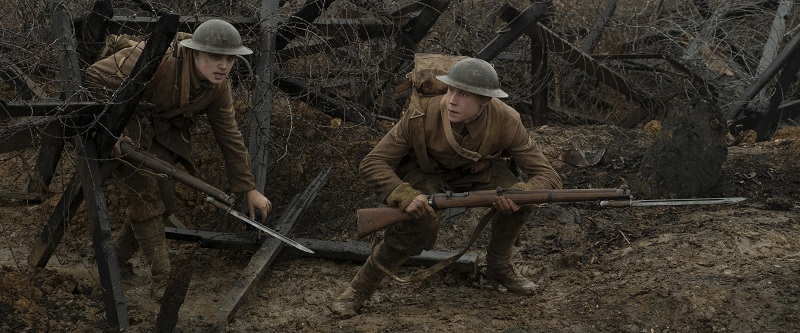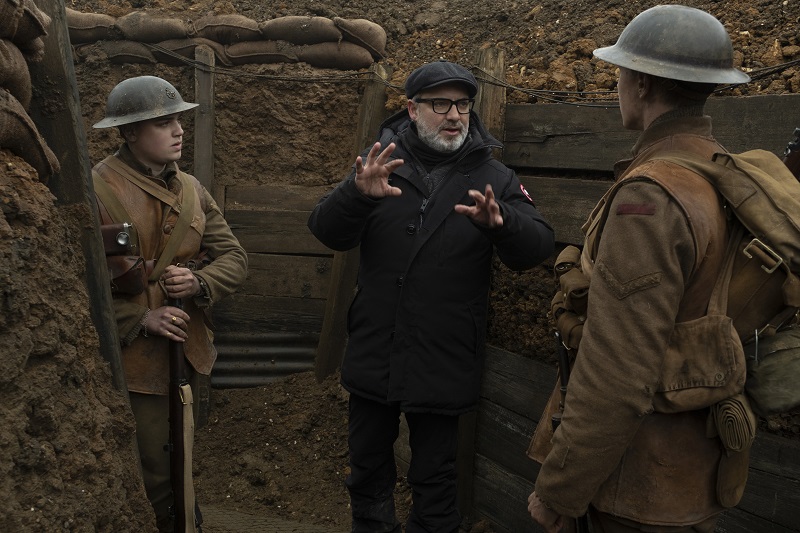After taking the James Bond cinematic world to new heights, with Skyfall and Spectre, filmmaker Sam Mendes walked away from all things 007. After experiencing his 1917, out now on DVD, Blu-Ray and Digital Download formats, one can see why a storyteller overseeing one of the great legacy storylines (the spy with that license to kill) would leave it to create in another direction.

1917 is incredibly personal for Mendes. He penned the script with Krysty Wilson-Cairns, who had done an incredible amount of research about World War I. Mendes phoned her and let it be known that he had a story idea and that he needed her help and expertise to make this script the jaw-dropping powerhouse it had the potential to be in Mendes’ head. After all, this was a story that emanated with his grandfather. The World War I veteran hinted at an experience of his over the years, never detailing too much about it after the reality of war would hinder his emotional capacity to tell his tale. The crux of it was that he and his buddy had been assigned to race to the front lines to try to send a message that a mission a legion of British soldiers were about to embark on would be a trap and turn into a massacre.
Wilson-Cairns and Mendes worked closely together and what they produced with their 1917 script was not only a tribute to the filmmaker’s grandfather, but to every veteran of The Great War. It is a love letter to heroism and selflessness that also wove a thrilling web that has enormously struck a chord with millions.
Their tale follows Lance Corporal Blake (Dean-Charles Chapman) and Lance Corporal Schofield (George MacKay). They are tapped by General Erinmore (Colin Firth) to make their way through the so-called no-man’s land and then the front lines to a British troup of 1,600 souls that are set to attack the Germans with an aggressive assault that will hopefully turn the tide of the war. Problem is, the Germans have moved their troops and they are ready for this invasion and in fact, to quote Erinmore, this will be a bloodbath. Adding layers to the drama and emotional cull of the story is the fact that Blake’s brother is part of that ill-fated unit. He could not be more determined to be successful in this highly challenging endeavor. Along the way, Germans will be just one of many foils to completing their mission effectively.
Another aspect of making this movie that inspired Mendes was this idea that he would shoot the film as if it was all one, continuous shot. Helping him make that dream a reality is the cinematographer who is unarguably one of the best … ever, Roger Deakins. He recently won an Oscar for Blade Runner 2049 and would win his second with 1917. It is simply extraordinary what he achieved visually with Mendes and that added so much richness to this story that will resonate with any soul who ventures down the filmmaker’s thrilling rabbit hole. There are cinematic moments that are about as gloriously gorgeous as cinema can be, and that is especially impressive given the landscape that Deakins and Mendes painted was that of war. Not exactly beauty incarnate. There are far too many moments to salute in this article. Let’s just say around every single corner is a fresh perspective and with it, a visual cornucopia of brilliance.
Often times in war films, the performances of the actors battling away on the screen gets lots in the spectacle. What Mendes got from his two leads are nothing short of movie miracles, particularly MacKay, who gives a star-making turn. There is determination, and then there is what is exhibited by both MacKay and Chapman in their characterizations of these two men. Yet, there is much more to their turns than being integral to the action sequences working so well. They have built characters (that all emanated from Mendes’ and Wilson-Cairns’ script) that pop off the screen. We, the audience, can connect to them on an emotive level that could not have us more emotionally tied to their well-being and successful conclusion of their mission. That is not an easy task for a screenwriter or a pair of actors working in this milieu. All four involved in bringing this to life have completely outdone themselves on so many levels.

There has also been a lot of talk that this is one of the best war movies of all-time. Let’s just say, it’s warranted as it is up there with the best of ‘em.
When it comes to the making of featurettes of the Blu-Ray, given the passion and personal connection to its entire existence, one must start with The Weight of the World: Sam Mendes. It commences with the screenwriting process and then delves into the filmmakers’ passion for the story, how he worked on the actual filmmaking aspect of the movie and more.
Next up, I dove into In the Trenches. The casting on this film was impeccable and this featurette spotlights how two relatively unknown actors scored the roles of a lifetime and how their performances will forever be impossible to separate from the technical marvel that is 1917. We even learn about what they did to get World War I ready, from carrying their lives on their backs to finding their inner strength to persevere.
Allied Forces: The Making of 1917 is a nice, behind-the-scenes look at how the film was made as two long connected shots. How that was achieved is a lesson in planning and fortitude. Before filming commenced, all involved had to work out a manner for keeping everything symmetrical, from logistical shooting, camera movement, production details and most importantly, how locations would sometimes send the greatest plans straight into the wind.

The Score of 1917 is a delightful featurette that introduces us to composer Thomas Newman and we get a look into the process of the score creator and how he worked with Mendes in capturing the sonic succulence that was integral to the overall power of the filmmakers’ latest. An absolutely stunning featurette arrives with the 10-minute Recreating History. It looks at Mendes and how he collaborated with Dennis Gassner.
Now, there are two commentary tracks, and both are pitch perfect. The first finds Mendes and he adds his insight via a wide channel of insight covering the countless arenas of making the movie. We even get some insight into his grandfather’s stories and how that sparked a passion for him that couldn’t end until he produced this film. The second commentary track comes from Deakins and that … well, that is bonafide brilliance of the highest order. Never thought I’d get the chance to hear a commentary track by one of the world’s greatest cinematographers and thus a front row into his work. That is exactly what is provided with his 1917 commentary track and it is beyond blissful.
Film Grade: A
Bonus Features: A

